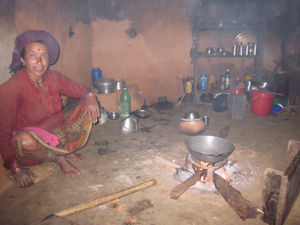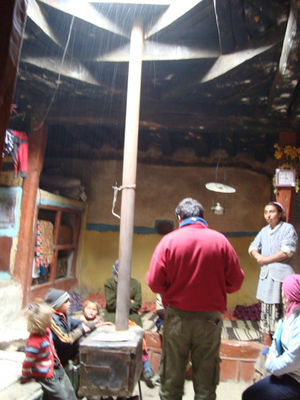Heating - Indoor Air Temperature
--> Back to Overview GIZ HERA Cooking Energy Compendium
Introduction
Human beings require a certain level of ambient air temperature in order to remain healthy. The mortality rate due to respiratory diseases, high blood pressure, and stroke risks increases when room temperatures fall below 20°C (Poor People´s energy outlook 2010, page 18). The international energy access debate suggests a minimum standard of daytime indoor air temperature of 12°C up to 18°C (PPEO 2010, page 33 and Defining Energy Access – proposed updated indicators http://www.hedon.info/tiki-download_forum_attachment.php?attId=23).
In many parts of this world, there are no problems in respect to these recommendations without the need for specific actions. However, in other areas – mainly in high altitude regions and the temperate zone – indoor air temperatures cannot be maintained on the required level without specific interventions. Examples for such geographic regions in developing countries are the South American Andes, the mountainous regions of Central Asia (Pamir, Himalaya, Alai, Tienshan) and the Atlas mountains in Morocco.
Indoor air temperature and therefore respective needs for heating is influenced by climate seasonality (duration of winter month) and altitude. Estimations by Hulscher et al. (FAO, 1997) indicate, that half a billion people in South and South-East Asia alone use stoves for space heating, whether as an absolute daily necessity in the coldest climates or for comfort during cooler seasons or at night.
Indoor air temperature is an important factor for a large number of populations. An overall number of households with needs to maintain an adequate indoor air temperature in developing countries is not estimated so far. Respective needs for maintaining indoor air temperature, like heating, contributes to energy poverty and it is linked to a number of Millenium Development Goals, as the following:
- Education (MDG 2) – indoor air temperature in social and public buildings, such as schools and hospitals,
- Gender quality and empower women (MDG 3),
- Health (MDG 4 and 5), and
- Environmental sustainability (MDG7) – due to fuel consumption and emission for heating.
|
|
Picture: In the high mountains of Nepal, households use an open fire for cooking and heating purposes indoor. Besides, the high needs for fuel wood, the indoor air temperatures are insufficient during the winter, and the exposure to smoke causes serious respiratory diseases and injuries caused by the open fire. (Source: Christoph Messinger, GIZ) |
Despite this high importance and relevance of indoor air temperature, it has been so far not adequately addressed in the field of development cooperation.
Though there is a lot of knowledge available in developed countries, for example on thermal insulation and efficient and cleaning heating stoves, little experience and knowledge are available on appropriate solutions for developing countries. This results in little available information on fuel demand and supply, technical heating stove designs, additional technical measures like house improvements and dissemination approaches for affordable, acceptable and accessible solutions in developing countries.
|
|
Picture: A house in the Western part of the Pamirs in Tajikistan, showing the typical construction of the Pamirian house. The hole in the roof, which is traditionally determined, is not closed because of missing finances and knowledge. Thus heat from the stove is leaving the room immediately and snow and cold air enter the room the whole winter season during day and night. (Source: Heike Volkmer, GIZ) |
Commonly, “space heating” is the core activity associated with the necessity to alleviate room temperatures. However, there are a number of different factors influencing indoor air temperature, such as:
- Housing conditions, e.g. construction, thermal insulation
- Fuels for space heating (quality and quantity)
- Space heating devices, e.g. traditional heating stove, improved heating stoves, multi-purpose stoves, heat exchanger
- User behaviour, e.g. fuel processing, use of oven, ventilation habits
Each of the factors will be described in the following chapters.
Housing conditions
The effect of improved cooking-heating stoves on indoor air temperature will be small, in case the heated room is not insulated, as the generated heat will leave the room immediately. In cold mountain areas, thermal insulation of buildings takes priority over improving space heating stoves or cooking stoves to gain overall minimum room temperatures and firewood savings (compare figure below).
|
|
|
Figure: Estimated savings possible on energy consumption in Afghanistan mountain areas, Sjoerd Nienhuys (2009) |
Especially, houses of the poor are badly insulated. In some regions, like in Pakistan, Afghanistan and Tajikistan, the roof has a whole, which is partly traditionally determined and functions as a smoke outlet, in case the stove has no chimney. Often windows are just a hole, which is closed by cellophane during winter with no insulating effect. In other regions, like in the Andes, people live in small low huts, which are badly ventilated to prevent heat losses, and therefore occupants are exposed to smoke harming the health of the dwellers.
Thermal insulation
In developing countries, especially poor people are still living in drafty houses with a lot of air exchange per hour. Thermal insulation enables to retain an acceptable temperature in rooms, because it prevents a high air exchange rate per hour in the house. There are many thermal insulation methods available worldwide. The selection of the methods depends on:
- Climatic conditions of the area
- Insulation of newly build houses or existent houses
- Availability of insulation material and skills to install
- Respective insulation value (also called R-value), which is the ratio of the temperature difference across an insulator
- Traditional perception of houses and housekeeping habits
The function of thermal insulation materials is based on three principles:
- Conduction – describes the heat transfer through a material
- Radiation – describes the ability of a matter to emit heat
- Convection – heat transfer trough temperature difference in a room, warm air moves upwards and cold air downwards
In general, natural and synthetic insulation materials are distinguished. Natural insulation materials are functioning on the principle of conduction and convection. Thus, thick layers of insulation materials are required. The advantages of natural insulation material are the low risk concerning condensation and mould in rooms, a good regulation of moisture and temperature in winter like in summer. Using natural insulation materials, like straw, saw dust, reed, algae’s, might be limited through their availability in respective quantities and quality. For example, straw is an appropriate and cheap insulation material, when not competing as livestock fodder. Natural insulation materials have to be protected against moisture and vermin to perform insulation on the long-term.
|
Algea used for thermal insulation in the Eastern part of Gorno-Badakhshan, Tajikistan (Picture: Christoph Wiedemann) |
Preperation of saw dust for the insulation of a roof in Tavdem, Gorno-Badakhshan, Tajikistan (Picture: Heike Volkmer) |
Available synthetic insulation materials are for example expanded polystyrene, reflective foils, glass or mineral wool. In case the material has a reflective foil, the thickness of the insulation layer can be thinner as heat is reflected back to the room (radiation).
|
[[File:]] |
[[File:]] |
|
Example of wall insulation with metalized plastic foil with a 2 mm Polyethylene (PE) layer. (Picure: Heike Volkmer) |
Wall insulation with expanded polystyrene in the suburbs of Bishkek, Kyrgyzstan (Picture: Heike Volkmer) |
Windows, roof hatch windows and doors are often energy-weak parts of houses. Depending on the households budget low cost options like roll curtains can prevent draft and mitigate heat losses through windows. Double-glazed windows (plastic or wooden) are required to close airtight to prevent draft. Furthermore, double-glazed windows use the greenhouse effect, when exposed to the sun, and heat the room additionally.
Low-cost options for insulating doors are as well curtains, insulation layers of wool, rubber foam, etc. A well airtight closing mechanism with overlaps of the door frame and the door itself as well as insulation layers have to be taken into consideration for newly build in doors.
|
[[File:]] |
[[File:]] |
|
A newly installed wooden double-glazed window in a Pamirian house in Gorno-Badakhshan, Tajikistan. The window was produced by trained local carpenters. (Source: Heike Volkmer) |
The design is based on placing the curtain on the inside, behind the glass window and behind the timber framing, thus reducing considerably the UV impact on the plastic. The second light blocking plasticized cotton cloth roll-up curtain is hardly affected by UV light, partly because it is often rolled up during the daytime. During nighttime it is rolled out, thus forming an insulating air-layer between the first and second curtain. In addition, a colourful curtain is a welcomed addition to the interior design of the house. (Picture: Heike Volkmer) |
Independently, which insulation material and method are chosen thermal insulation in existing houses requires:
- local expertise for planning, and construction needs to be developed on materials, the respective processing and the installation methods,
- behaviour change of the occupants concerning ventilation and humidity control,
- post-fitting of roofs and walls must assure it does not affect their strength or earthquake resistance, and
- usually, adapted heating devices.
1.2.Passive solar heating
Passive solar designs of houses use the energy of the sun to heat up rooms, thus lowering energy requirements and keep the house comfortably warm. The goal of all passive solar heating systems is to capture the sun’s heat within the building elements. The heat gain or loss from solar energy depends on exposure of the house and on the hemisphere. In the southern hemisphere windows of the house should face north to gain most benefit from the sun, in the northern hemisphere vice versa facing south. Furthermore protection from wind, orientation of doors, and buffer spaces like porches needs to be planned.
Additional information:
- Experience on supporting thermal insulation through micro loans in Gorno-Badakhshan in Tajikistan. Applied thermal insulation measures are the insulation of ceiling, roof or floor with natural insulation materials and the installation of double-glazed windows and roof hatch windows, as well as doors. Micro loans for thermal insulation - A Product Documentation Based on Experience in Tajik Gorno-Badakhshan in English http://naturalresources-centralasia.org/assets/files/2010-09-15_product_documentation_thermal_FINAL_eng.pdf
- Information on techniques developed in the Pakistan Northern Areas, Himalayas: Wall Insulation Techniques for Buildings in High Mountain Areas, (2000) as well as on the development of roof hatch windows http://www.nienhuys.info/documents-papers.html
- Organisation with activities on thermal insulation of buildings mainly with natural insulation materials (e.g. reed and straw) in Central Asia, Center for Energy Efficient Building in Central Asia (CEEBA) - http://www.ceeba.kg/?ln=en
- Assessing the energy consumption patterns with respective solution valuation in Badakhshan/ Afghanistan: Energy, insulation and cook stove improvement in Badakhshan by Sjoerd Nienhuys http://www.hedon.info/article1602&highlight=thermal%20insulation
- General information on the use of solar energy in buildings http://passivesolar.sustainablesources.com/#guidelines
- GERES - passive solar housing project in North-East India http://www.saesup.org/case-study-6-psh-geres-inde.html
- Impact study of housing improvements on health on the Northern Areas of Pakistan conducted by AKHS, P and AKPBS,P (2001): The Impact of BACIP Interventions on Health and Housing in the Northern Areas, Pakistan http://www.mountainforum.org/sites/default/files/pub/1295.pdf
Top of the page





















